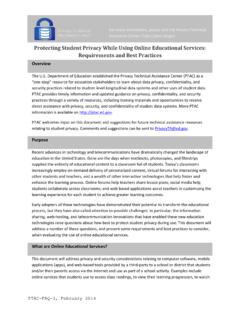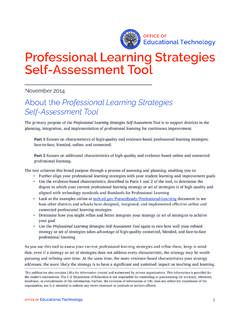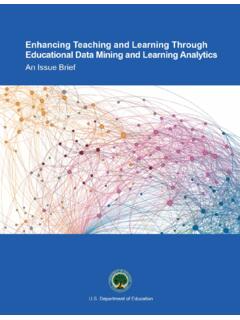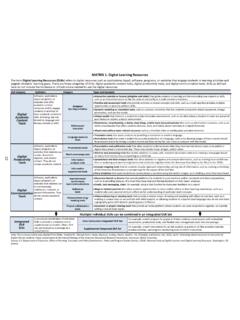Transcription of Reimagining the Role of Technology in Higher Education
1 1 Reimagining the Role of Technology in Higher Education A Supplement to the National Education Technology PlanJANUARY Department of EducationCONTENTSI ntroduction 4 Chapter One What is Higher Ed? A Student Prospectus 6 Chapter Two Transforming Our Ecosystem: 17 Learning, Teaching, and Assessment Section I. Engaging and Empowering Learning Through Technology 17 Recommendations 22 Section II. Teaching with Technology 24 Recommendations 37 Section III. Assessments Enabled by Technology 38 Recommendations 43 Chapter Three Systems That Support Student Success 46 Recommendations 58 Chapter Four Leadership that Enables Innovation and Change 60 Recommendations 67 Chapter Five The Future of Higher Education 69 Conclusion 74 Appendix A.
2 Resources 75 Appendix B. Acknowledgements 79 Appendix C. The Development of the Higher Education Supplement Department of EducationJohn King SecretaryOffice of Educational TechnologyJoseph South DirectorJanuary 2017 Version Are Not EndorsementsThis document contains references to materials that are provided for the user s convenience. The inclusion of these reference materials is not intended to reflect their importance, nor is it intended to endorse any views expressed, or products or services offered. These reference materials may contain the views and recommendations of various subject matter experts as well as hypertext links, contact addresses, and websites to information created and maintained by other public and private organizations. The opinions expressed in any of these materi-als do not necessarily reflect the positions or policies of the Department of Education (Department).
3 The Department does not control or guarantee the accuracy, relevance, timeli-ness, or completeness of any outside information included in these materials. These references should not be construed as an endorsement by the Department or the and AvailabilityThis report is in the public domain. Authorization to reproduce this report in whole or in part is granted. While permission to reprint this publication is not necessary, the suggested citation is: Department of Education , Office of Educational Technology , Reimagining the Role of Technology in Higher Education : A Supplement to the National Education Technology Plan, Washington, , report is available on the Department s Website at Requests for alternate format documents such as Braille or large print should be submitted to the Alternate Format Center by calling 202-260-0852 or by contacting the 504 coordinator via email at OF Educational TechnologyIntroduction This document is an outgrowth of the 2016 National Education Technology Plan (NETP).
4 The NETP presents a shared vision and call to action for transformational learning enabled by Technology at all levels of our Education system. Building on the work of leading educa-tion researchers; state, district, school, and Higher Education leaders; teachers; developers; entrepreneurs; and nonprofit organizations, the NETP recommends actions that would enable everywhere, all-the-time learning and ensure greater equity and accessibility to learning opportunities over the course of a learner s lifetime. While the concepts, recommendations, and examples in the NETP are applicable to Higher Education and postsecondary learning, they draw extensively from P-12 frameworks and rely heavily on its terminology and promising practices, but are not primarily applicable to the complex context of postsecondary learning or devote specific focus to its promising Higher Education Supplement to the 2016 NETP builds on the principles described in each of the NETP s five sections learning, teaching, leadership, assessment, and infrastructure and examines them in the context of Higher Education .
5 The supplement embraces the NETP themes of lifelong learning, equity, and accessibility and supports the NETP s assertion that Technology must serve the needs of a diverse group of students seeking access to high-quality postsecondary learning experiences, especially those students from diverse socioeconomic and racial backgrounds, students with disabilities, first-generation students, and working learners at varying life stages all with differing educational goals, but who all share the desire to obtain a postsecondary for instructors, administrators, policymakers, educational Technology developers, funders, employers, and learners, the supplement articulates a vision and action plan that responds to an urgent national priority postsecondary success for all Americans. It describes specific actions these stakeholders can take to ensure that the system of Higher Education contin-ues to innovate and improve to provide all learners with opportunities for personal growth and prosperity.
6 It examines the role of Technology in serving an increasingly diverse and dispersed student body that is growing and evolving in size and composition. For example, leaders working together across sectors can use Technology to enable fluid transitions between a lifetime of learning experiences and career pathways, and to underpin an infrastructure of networked institutions, Education providers, community organizations, and Technology developers. Academic and tech - nology leaders can also work together to reduce achievement gaps and increase completion rates for a diverse student population. And finally, through Technology -enabled everywhere, all-the-time learning, institutions, existing and new providers, workplaces, and employers can provide accessible and flexible educational experiences for all students. But this is possible only when Technology is developed on an evidence-based foundation that draws from the learning sciences and is implemented using effective strategies that focus on improving the quality of learning experiences and improving the outcomes for all , beyond the impact of Technology on students and faculty in individual classrooms and at institutions, this supplement discusses the various ways in which Technology can enable system-wide and broader ecosystem applications of collaborative solutions to the core challenges of access, affordability, and OF Educational TechnologyThis supplement highlights many examples of innovative programs and institutions that are already engaged in this work, as well as resources for stakeholders looking for ideas and support to innovate.
7 It also offers principles, recommendations, and examples exclusively focused on the unique challenges of the Higher Education ecosystem as well as innovative educational Technology solutions tailored to the needs of Higher Education the Supplement is OrganizedIn Chapter One, this supplement provides context and discusses the changing nature of students in postsecondary Education , including who they are and what we know about how they learn. In Chapter Two, the supplement addresses the main topics of the 2016 NETP through the lens of postsecondary learning, namely, teaching, learning, and assessment. Chapter Three examines the educational infrastructure as well as other systems necessary to support Technology -enabled transformative learning experiences throughout the lifetime of learners. Chapter Four discusses collaborative postsecondary leadership structures that enable innovation and participation from all stakeholders in defining what is to be learned and how and where learning takes place.
8 Chapter Five considers the role of Technology in the future success of an emerging Higher Education and postsecondary this supplement, examples, case studies, resources, and definitions illustrate the discussion in the KeyInformationExampleCase StudyResources6 OFFICE OF Educational Technology1. What is Higher Ed? A Student ProspectusToday s average student is no longer the 18-year-old whose parents drive her up to State U in a minivan stuffed with boxes. Instead, the new normal student may be a 24-year-old returning veteran, a 36-year-old single mother, a part-time student juggling work and college, or the first-generation college student. The faces we picture as our college hopefuls can t be limited by race, age, income, zip code, disability, or any other factor. Ted Mitchell, Under Secretary, Department of EducationReimagining Higher EducationHigher Education has never mattered so much and to so many as a means of social mobility, an engine of economic growth, and a defender of democracy.
9 In order for Higher Education to fulfill its promise as a great equalizer, we need continued innovation that can move us toward increased access, affordability and equity. This innovation will develop an ecosystem that will include a range of opportunities for a variety of high-quality educational experiences and credentials with marketplace value suited for the differing needs of students. Historically, Higher Education has been viewed through the lens of its institutions1 and our public dialogue has been framed by these categorizations. We have tended to consider students by the type of institution they attend: for example, community college students, Ivy League students, or graduate school students. This may cause us to inadvertently assume that students in those institutional categories are largely similar and overlook the circumstances of many students lives that are incompatible with the current scheduling, course sequencing, financial aid offer-ings, and other structural constraints imposed by this system.
10 This can unintentionally present Higher Education as easily available to everyone, located in a specific place, taking place formally over discrete periods of time, and mostly optional for workforce advancement and may also cause us to overlook and undervalue learning experiences that occur apart from discrete, formal institutional experiences. Because of this, whether a stu-dent succeeds in Higher Education may be determined more by the student s ability to navigate institutional structures than by their academic placing students at the center, we can frame our understanding and design of programs, course offerings, and institutions based on their attributes and needs. In this way, our institu-tional policies and practices can better help students overcome barriers to successful completion. In addition, we can expand our ability to provide Higher Education opportunities for a greater number of students, with a broader range of needs, at a lower OF Educational Technology New Normal Students Over the last generation, college enrollment has increased3 due to economic recession, deindustri-alization, and increasing demand for skilled workers.














